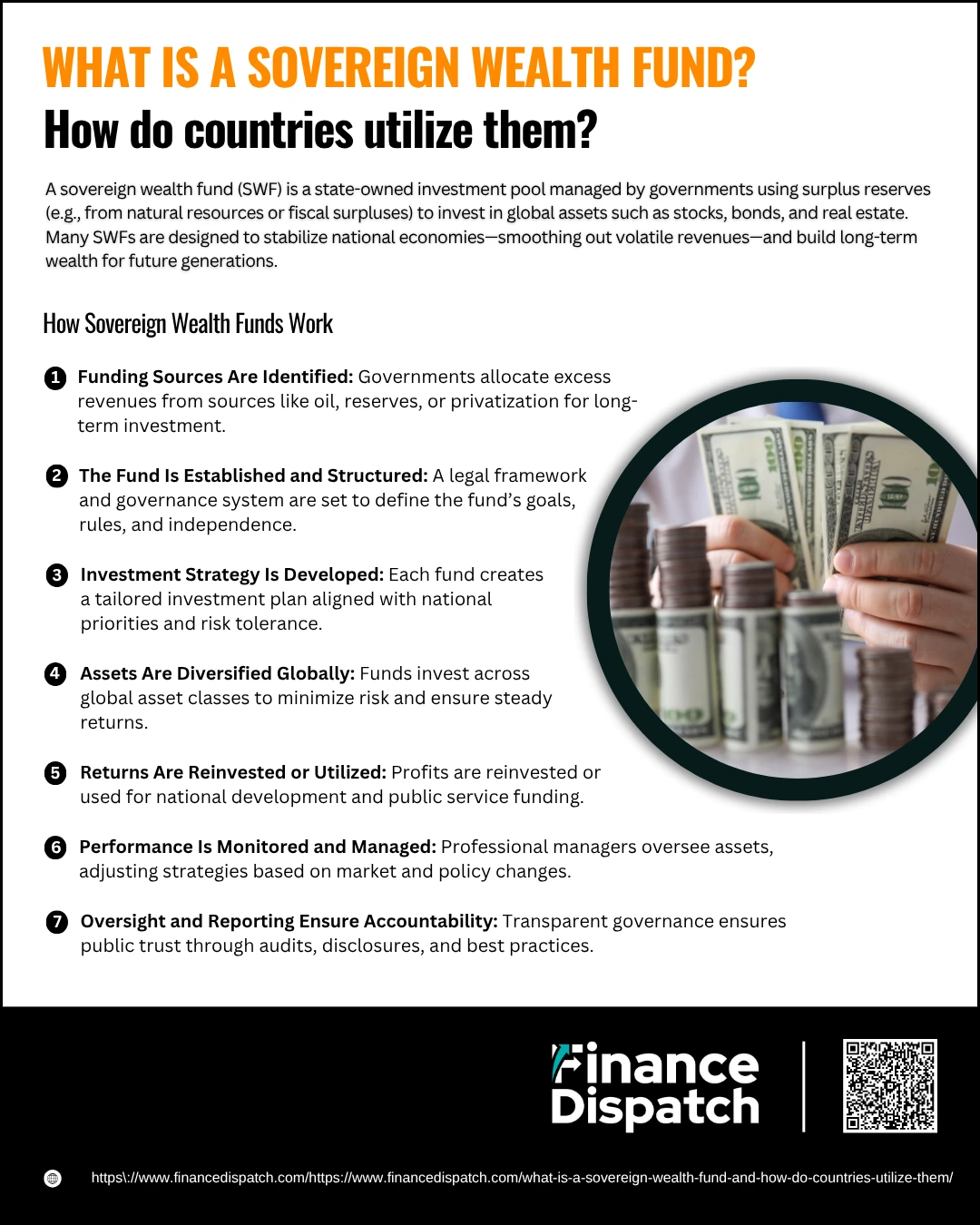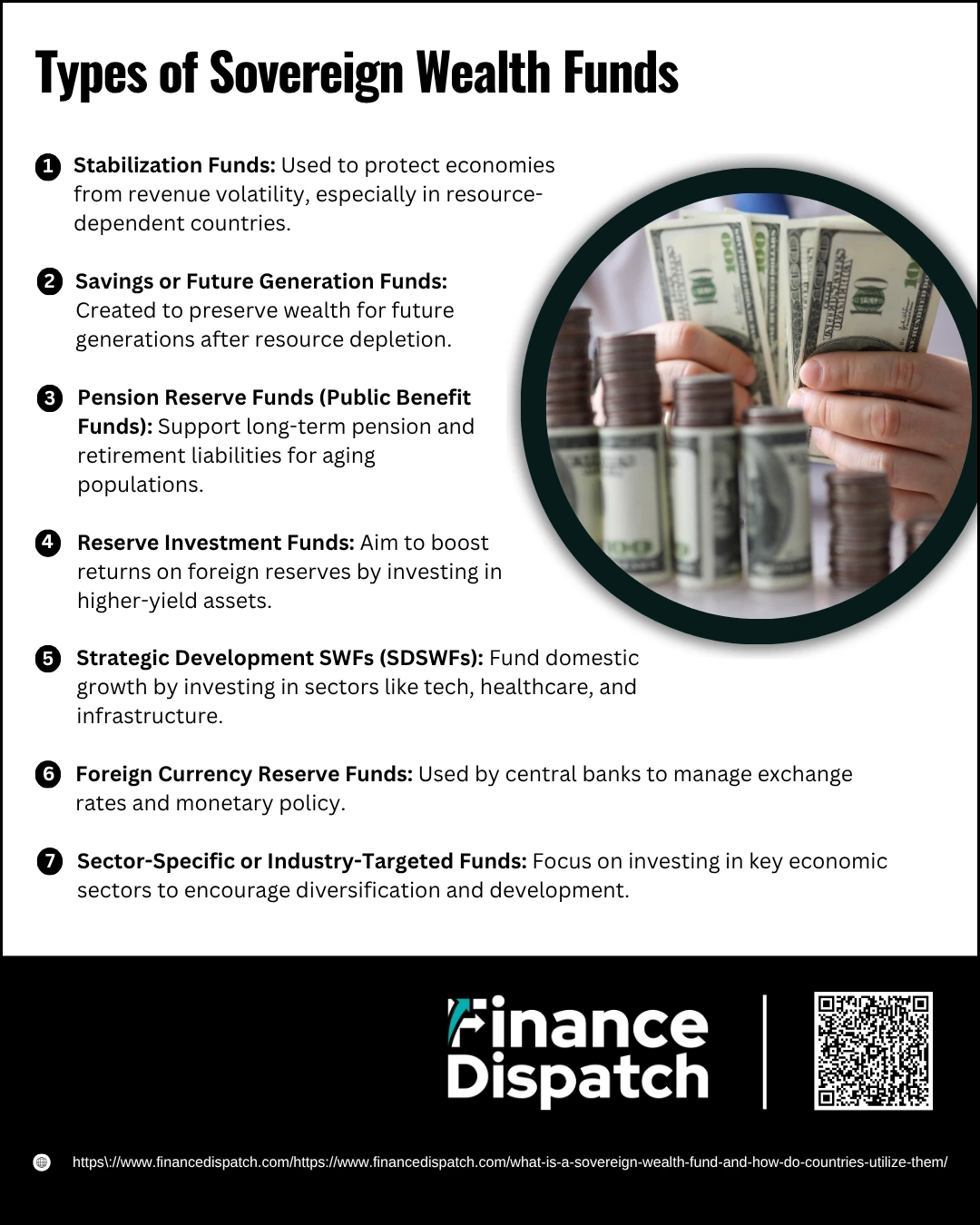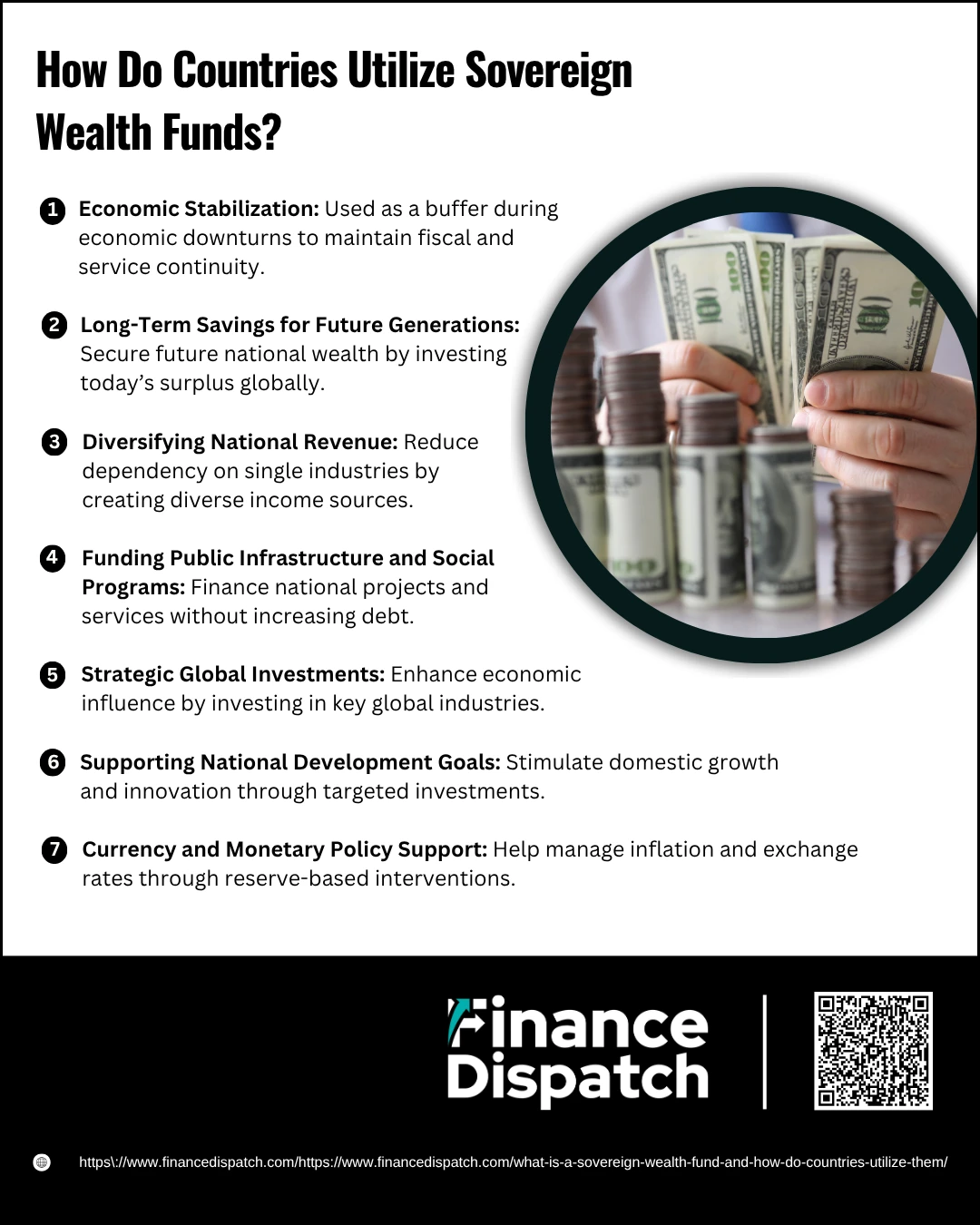A Sovereign Wealth Fund (SWF) is more than just a pool of government-held money—it’s a strategic tool nations use to secure their financial future. Funded by surplus revenues such as oil profits, foreign currency reserves, or trade surpluses, these state-owned investment funds are designed to generate long-term returns and stabilize national economies. While some countries use SWFs to prepare for economic downturns or the depletion of natural resources, others invest to gain global financial influence or fund domestic priorities like infrastructure and social programs. As these funds grow in size and importance, understanding how they operate—and how countries actually utilize them—offers key insight into modern economic policy and international financial power.
What is a Sovereign Wealth Fund?
A Sovereign Wealth Fund (SWF) is a state-owned investment fund created and managed by a government to invest its surplus revenues. These funds are typically derived from sources such as natural resource exports (like oil and gas), foreign exchange reserves, budget surpluses, or proceeds from privatizations. Unlike central bank reserves, which are held primarily for monetary policy purposes, SWFs are actively invested in a variety of global assets—including stocks, bonds, real estate, and infrastructure—with the aim of generating long-term financial returns. The core objective of an SWF is to preserve and grow a nation’s wealth over time, ensuring economic stability and benefiting future generations.
 How Sovereign Wealth Funds Work
How Sovereign Wealth Funds Work
Sovereign Wealth Funds (SWFs) serve as long-term investment vehicles for national governments, turning economic surpluses into diversified global assets. These funds are typically designed to reduce economic vulnerability, support government budgets during downturns, invest in strategic industries, or prepare for a post-resource future. The operation of an SWF involves several deliberate and well-structured steps, each essential for achieving sustainable financial growth while safeguarding the nation’s wealth.
Here’s how sovereign wealth funds typically work:
1. Funding Sources Are Identified
The process begins when a government identifies surplus revenues that can be set aside for long-term investment. These sources often include profits from commodity exports (especially oil and gas), excess foreign exchange reserves, fiscal budget surpluses, or proceeds from privatization of state-owned enterprises. The decision to divert these funds into an SWF reflects a commitment to financial planning beyond short-term expenditures.
2. The Fund Is Established and Structured
Once funding is secured, a sovereign wealth fund is formally established with a legal and administrative structure. This includes setting up a governing body, defining the fund’s mandate (e.g., savings, stabilization, strategic development), and outlining rules for investment decisions, risk management, and accountability. Some SWFs are designed to operate independently from the central government to avoid political interference.
3. Investment Strategy Is Developed
Every SWF tailors its investment strategy to match its national priorities and financial objectives. For example, a savings fund might focus on capital preservation and long-term returns, while a stabilization fund emphasizes liquidity to cushion the economy during crises. The strategy defines which asset classes the fund will target—ranging from safe government bonds to riskier equities or private ventures.
4. Assets Are Diversified Globally
To minimize risks and maximize returns, SWFs invest across a wide spectrum of global assets. This often includes public equities, fixed-income securities, real estate, infrastructure, private equity, and even technology startups. The goal is to avoid overexposure to any single market or sector and ensure steady growth, regardless of domestic economic conditions.
5. Returns Are Reinvested or Utilized
The income generated from investments can be reinvested to grow the fund further or redirected toward national development goals. Some SWFs distribute a portion of returns to support social programs, infrastructure projects, or public services. Others accumulate returns to serve as a financial buffer for future generations.
6. Performance Is Monitored and Managed
Professional fund managers or appointed investment teams oversee the day-to-day management of the portfolio. They adjust asset allocations based on market performance, emerging opportunities, and shifts in national priorities. Some funds adopt passive strategies, while others engage in active management to boost returns.
7. Oversight and Reporting Ensure Accountability
Transparent governance is crucial for maintaining public trust and global credibility. Many SWFs follow international best practices, such as the Santiago Principles, which promote disclosure, clear investment objectives, and operational independence. Regular audits, public reports, and performance metrics help ensure that the fund serves the national interest responsibly and effectively.
 Types of Sovereign Wealth Funds
Types of Sovereign Wealth Funds
Sovereign Wealth Funds (SWFs) vary widely in their structure and purpose, depending on the goals of the government that created them. While all SWFs aim to manage national wealth through investment, the specific objectives—such as saving for future generations, stabilizing the economy, or funding development—shape how each fund is designed and operated. Below are the main types of sovereign wealth funds, categorized based on their core functions and funding strategies.
1. Stabilization Funds
These funds are designed to cushion the impact of economic volatility, especially in countries heavily dependent on commodity exports like oil or gas. When prices drop or revenues decline, governments can draw from these funds to maintain public spending and economic stability.
2. Savings or Future Generation Funds
Also known as intergenerational funds, these SWFs focus on long-term wealth accumulation. They preserve surplus revenues (often from nonrenewable resources) to benefit future generations, ensuring that today’s wealth creates lasting economic security.
3. Pension Reserve Funds (Public Benefit Funds)
These funds are established to support a country’s pension system or future retirement obligations. They help manage the financial pressures of aging populations and are usually invested with a long-term horizon to match future liabilities.
4. Reserve Investment Funds
Aimed at enhancing returns on foreign exchange reserves, these funds convert a portion of a country’s central bank reserves into higher-yield investments. This strategy helps governments diversify beyond low-return government bonds.
5. Strategic Development Sovereign Wealth Funds (SDSWFs)
These funds are used to promote national development and strategic interests. Investments are often made in sectors like technology, infrastructure, or healthcare to stimulate economic growth, innovation, or political goals.
6. Foreign Currency Reserve Funds
While not always classified as SWFs, these funds are similar in structure and function. They are managed by central banks or finance ministries and are used to stabilize currency, manage exchange rates, or support monetary policy.
7. Sector-Specific or Industry-Targeted Funds
Some SWFs are created to support specific industries or economic sectors, such as renewable energy, tourism, or manufacturing. These funds help diversify the economy by investing in emerging or underdeveloped areas.
 How Do Countries Utilize Sovereign Wealth Funds?
How Do Countries Utilize Sovereign Wealth Funds?
Sovereign Wealth Funds (SWFs) are powerful financial instruments that allow governments to put excess revenues to work for the long-term benefit of their economies and citizens. While the core idea is to invest surplus wealth for sustainable returns, how each country uses its SWF depends on its economic structure, political goals, and national priorities. From stabilizing budgets to investing in strategic sectors, SWFs are utilized in various ways to strengthen and future-proof a nation’s financial foundation.
1. Economic Stabilization
Countries prone to volatile revenue sources—especially from commodities like oil—use SWFs to smooth out budget deficits during economic downturns. These funds act as a financial buffer, helping maintain public services and economic activity when income drops.
2. Long-Term Savings for Future Generations
Many nations, especially those with nonrenewable resource wealth, use SWFs to preserve value for future generations. By investing today’s surpluses in global assets, these funds build a financial cushion for the time when resource income may no longer be available.
3. Diversifying National Revenue
SWFs help countries reduce reliance on a single industry or source of income. By investing in a broad range of sectors—such as real estate, technology, healthcare, or global equities—governments create multiple income streams to support economic resilience.
4. Funding Public Infrastructure and Social Programs
Some countries use returns from SWFs to fund major infrastructure projects like roads, schools, and hospitals or to support social initiatives such as education and healthcare. This helps enhance public services without increasing national debt.
5. Strategic Global Investments
SWFs are often deployed to invest in foreign companies or assets that align with a nation’s economic or geopolitical goals. For instance, countries may invest in industries that support technological advancement, energy independence, or global influence.
6. Supporting National Development Goals
In some cases, SWFs are used domestically to boost local industries, support innovation, or develop sectors critical to the country’s growth. These investments can stimulate job creation and improve competitiveness.
7. Currency and Monetary Policy Support
Certain funds derived from foreign currency reserves are utilized to manage exchange rates, reduce inflation, or stabilize the national currency—helping maintain a favorable trade balance and economic environment.
Benefits of Sovereign Wealth Funds
Sovereign Wealth Funds (SWFs) offer governments a flexible and strategic way to manage surplus revenues and invest in long-term prosperity. By channeling excess wealth into diverse global assets, these funds not only protect economies from volatility but also create opportunities for national growth and development. Their benefits extend beyond immediate financial returns, helping countries plan for the future, stabilize their economies, and enhance their global influence.
Key Benefits of Sovereign Wealth Funds:
1. Economic Stability
SWFs help shield economies from external shocks such as commodity price swings or financial crises by providing a financial buffer during downturns.
2. Long-Term Wealth Creation
These funds enable countries to convert temporary surpluses into lasting financial assets, ensuring economic security for future generations.
3. Diversification of National Income
By investing in a wide range of industries and asset classes, SWFs reduce a country’s dependence on a single revenue source like oil or taxes.
4. Funding for Public Services and Infrastructure
Returns generated from SWFs can be used to support national infrastructure projects, healthcare, education, and other essential services without increasing public debt.
5. Support for Strategic Sectors
Governments can use SWFs to invest in sectors critical to national interest—such as energy, technology, or defense—supporting innovation and competitiveness.
6. Global Investment Influence
Large SWFs allow countries to gain a foothold in global markets, shaping international economic trends and strengthening geopolitical influence.
7. Pension and Social Security Support
Some SWFs are designed to fund public pensions or social welfare programs, helping address the financial challenges of aging populations.
8. Foreign Exchange and Currency Management
Reserve-based SWFs assist in managing exchange rates and reducing inflationary pressures by stabilizing capital flows and supporting monetary policy.
Risks and Criticisms of Sovereign Wealth Funds
While Sovereign Wealth Funds (SWFs) are praised for their ability to build national wealth and support economic stability, they are not without risks or controversy. As state-controlled investment vehicles managing trillions of dollars globally, SWFs face intense scrutiny regarding transparency, political influence, and ethical practices. Critics argue that without proper oversight, these powerful funds can be misused or pose challenges to both domestic and international financial systems.
Key Risks and Criticisms of Sovereign Wealth Funds:
1. Lack of Transparency
Some SWFs operate with limited public disclosure, raising concerns about accountability, governance, and potential misuse of national wealth.
2. Political Interference
Governments may pressure SWFs to support local projects or political agendas, diverting the fund’s focus from long-term returns to short-term political gain.
3. Geopolitical Tensions
When SWFs invest in sensitive foreign industries (like defense or tech), they can trigger national security concerns and protectionist responses from host countries.
4. Ethical and Environmental Conflicts
SWFs that profit from fossil fuels while nations pledge climate action, or that invest in controversial regimes, face criticism for misaligned values.
5. Market Disruption
Due to their sheer size, large SWFs can influence global markets, potentially distorting asset prices or causing panic during rapid sell-offs.
6. Overdependence on Volatile Revenues
SWFs funded by commodities like oil are vulnerable to price fluctuations, which can impact the fund’s contributions and long-term viability.
7. Limited Domestic Benefit
In some countries, citizens see little direct benefit from their SWF’s success, especially when returns are reinvested abroad rather than used for public development.
8. Risk of Corruption and Mismanagement
Without strong governance structures, SWFs can become vehicles for corruption, as seen in high-profile scandals involving misuse of billions in public funds.
Global Comparison of Sovereign Wealth Funds
Sovereign Wealth Funds (SWFs) exist across the world in various forms, reflecting the economic priorities, funding sources, and investment strategies of their respective countries. While some funds are built on natural resource exports like oil and gas, others are financed through foreign exchange reserves or budget surpluses. Their size, transparency, and impact vary widely—from stabilizing national economies to influencing global markets. The table below highlights a comparison of some of the world’s largest and most influential SWFs.
Comparison Table of Major Sovereign Wealth Funds
| Country | Fund Name | Assets Under Management (2025) | Primary Funding Source | Key Characteristics |
| Norway | Government Pension Fund Global | $1.74 trillion | Oil revenues | Largest SWF globally; strong transparency and ESG focus |
| China | China Investment Corporation | $1.33 trillion | Foreign exchange reserves | Focuses on strategic global investments |
| UAE (Abu Dhabi) | Abu Dhabi Investment Authority | $1 trillion+ | Oil and gas revenues | Major player in real estate and infrastructure |
| Saudi Arabia | Public Investment Fund (PIF) | $925 billion | Oil revenues | Aggressive growth strategy; invested in sports & tech |
| Singapore | Temasek Holdings & GIC | $400+ billion combined | Budget surpluses & reserves | Strategic investments in innovation and global markets |
| Kuwait | Kuwait Investment Authority | $1 trillion | Oil revenues | Oldest SWF; conservative, long-term focus |
| Qatar | Qatar Investment Authority | $525 billion | Natural gas revenues | Active in European real estate and sports investments |
| Hong Kong | HK Monetary Authority Investment Portfolio | $510 billion | Foreign reserves | Managed by central bank; maintains currency stability |
| USA (Alaska) | Alaska Permanent Fund Corporation | $79.6 billion | Oil royalties | Pays annual dividends to residents |
| Japan | Government Pension Investment Fund | $1.63 trillion | Pension contributions | Technically a pension fund, but similar to SWF in scale |
The Future of Sovereign Wealth Funds
As global economies face increasing uncertainty, shifting energy landscapes, and rising geopolitical tensions, the role of Sovereign Wealth Funds (SWFs) is evolving rapidly. In the years ahead, SWFs are expected to become more influential—not just as financial investors, but as strategic tools for shaping national agendas. Many funds are moving beyond traditional asset classes and embracing sustainability, innovation, and technology, aligning their portfolios with environmental, social, and governance (ESG) goals. With climate change, demographic shifts, and economic diversification at the forefront, the future of SWFs will likely involve greater transparency, more active management, and deeper integration with national development plans. As new funds emerge from developing economies and established ones adapt to global pressures, SWFs will continue to play a vital role in building financial resilience and long-term prosperity for nations worldwide.
Conclusion
Sovereign Wealth Funds have emerged as powerful instruments for managing national wealth, offering countries a means to transform surplus revenues into long-term financial security and economic influence. Whether used for stabilizing budgets, investing in future generations, or driving strategic growth, SWFs play a vital role in shaping the financial future of nations. Despite challenges such as transparency concerns, political risks, and market volatility, their impact on both domestic and global economies is undeniable. As more governments recognize the value of these funds, the focus will increasingly shift toward responsible governance, sustainable investing, and aligning SWFs with broader national goals. In a world of constant change, sovereign wealth funds stand as a cornerstone of economic foresight and resilience.



